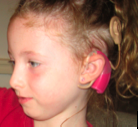Technical School
Cochlear Implant
A cochlear implant is an electronic device that consists of surgically implanted internal electrodes and a computerized speech processor worn externally. A cochlear implant is different from a hearing aid. While a hearing aid amplifies sound and the child uses their existing hearing to listen, a cochlear implant transmits sounds electronically to the nerve fibers, bypassing damaged hair cells.
A simple description of how an implant works is available at the following site: US FDA/CDRH: Cochlear Implants - What is a Cochlear Implant?
If your child has a cochlear implant, you would have received detailed instructions on the care and use of the processor. However, some general guidelines to keep in mind are:
a) Static electricity may corrupt the program on your child’s processor. Avoid plastic slides and playground equipment that can increase static electricity.
b) Ask your audiologist to enable the audio alarm that signals battery replacement. When you hear the alarm, replace the battery within a few minutes.
c) always keep extra cables for your child’s implant and an extra magnet coil. If you see any cracks in the cables, or your child’s implant doesn’t work, change these parts and check the processor again.
More detailed information on troubleshooting your specific type and model of cochlear implant is available at the following site:
Troubleshooting your cochlear implant
The contents of this web page are available in Arabic Danish